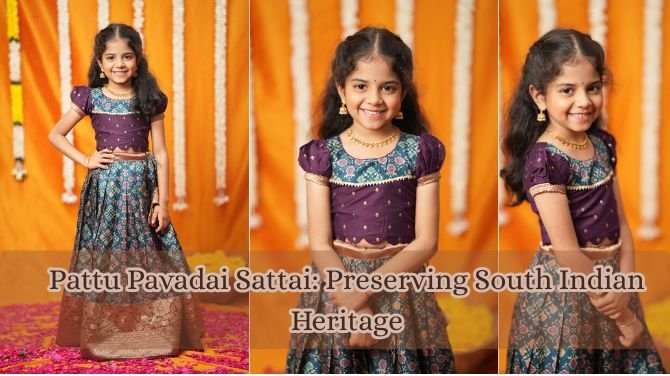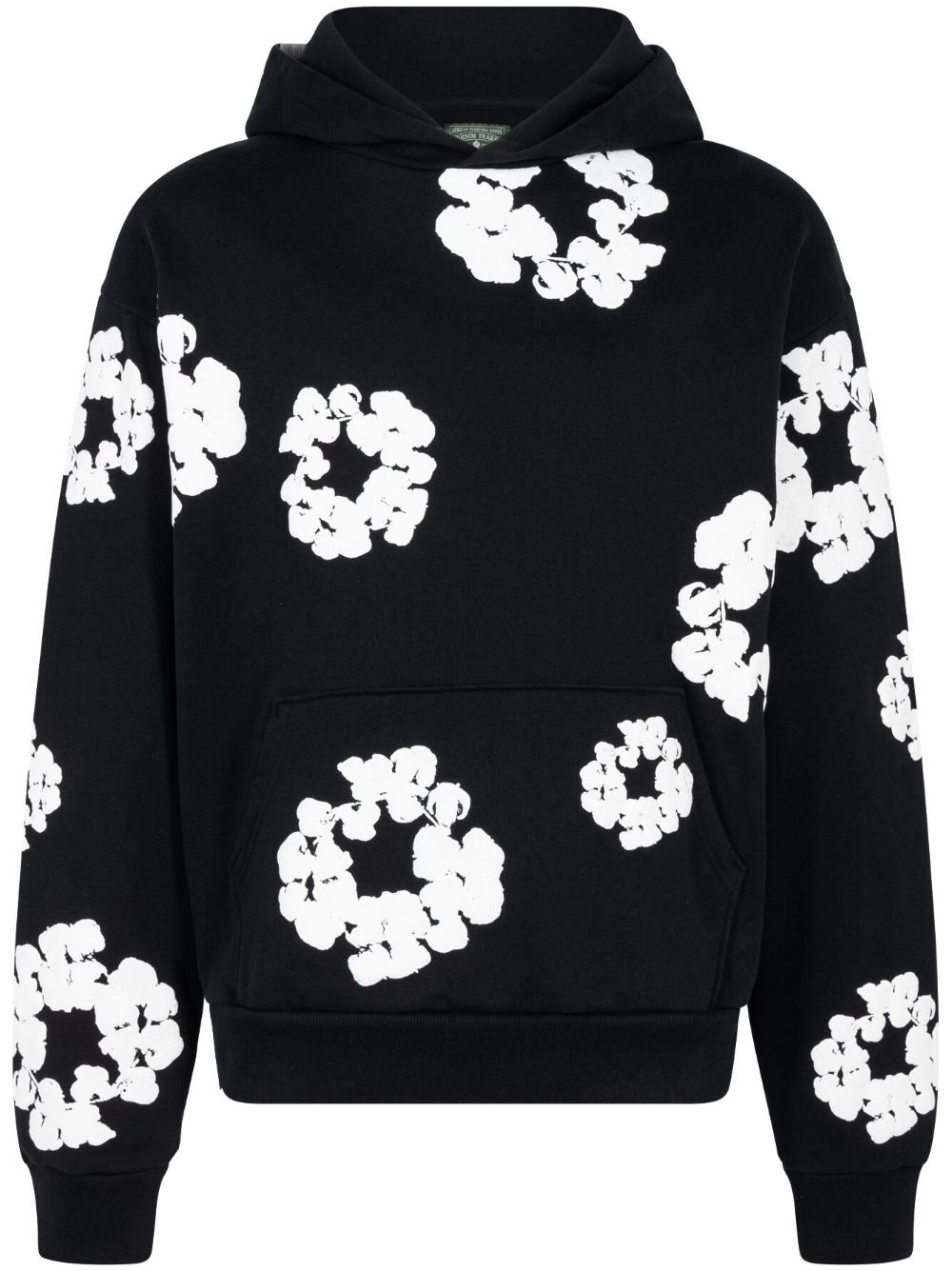South India is known for its rich cultural traditions, vibrant festivals, and exquisite craftsmanship in textiles. Among its many traditional outfits, the Pattu Pavadai Sattai holds a special place. This elegant silk ensemble is more than just attire—it’s a cultural symbol that carries stories of tradition, family, and identity. Passed down through generations, it remains one of the most beloved garments for girls and young women, representing the beauty of heritage and the continuity of South Indian values.
The Origins and Legacy of Pattu Pavadai Sattai
The Pattu Pavadai Sattai, also known as the silk skirt and blouse set, has been a part of South Indian wardrobes for centuries. Traditionally, it was worn by young girls and teenagers during festivals, family gatherings, and ceremonies. The term “pattu” means silk, “pavadai” means skirt, and “sattai” refers to the blouse. Together, they form an attire that combines elegance, modesty, and cultural charm.
In ancient times, these garments were woven by skilled artisans using pure silk threads, often adorned with zari borders, temple designs, and intricate motifs. The choice of fabric and color was often symbolic—bright hues for festive joy and subtle tones for religious ceremonies. Mothers and grandmothers would carefully choose or hand-stitch these garments, turning them into cherished heirlooms that reflected both love and tradition.
Cultural Significance Across Generations
What makes the Pattu Pavadai Sattai timeless is its deep cultural meaning. It’s often the first formal traditional outfit a girl wears in her life, marking her connection to her roots. From her first temple visit to milestone celebrations like puberty ceremonies or family weddings, this dress accompanies her through important stages of life.
In many families, the Pattu Pavadai is also a symbol of blessings and auspiciousness. It’s gifted during festive occasions like Diwali or Pongal, and during temple festivals when young girls are dressed like goddesses for rituals. Wearing this attire is not just about fashion—it’s a way of showing respect for heritage and continuing centuries-old customs that celebrate femininity and grace.
Artistry and Craftsmanship Behind the Attire
Each Pattu Pavadai Sattai is a masterpiece of craftsmanship. The process begins with handwoven silk sourced from regions like Kanchipuram, Arni, and Dharmavaram—famous for their lustrous silk and traditional weaving techniques. Artisans skillfully weave zari borders, floral motifs, and geometric patterns that reflect regional artistry. The blouse is tailored to fit perfectly, often embellished with embroidery, sequins, or hand-painted designs.
The choice of color combinations is another distinctive feature. Vibrant shades of magenta, emerald green, and royal blue paired with gold borders create a regal look that captures the essence of South Indian culture. For younger girls, designers now offer lightweight versions made with soft silk or blended fabrics, ensuring comfort while maintaining the traditional aesthetic.
The Role of Pattu Pavadai Sattai in Celebrations
In South Indian households, festivals and weddings are incomplete without traditional attire. During Navratri, young girls dressed in colorful silk pavadais light lamps and participate in cultural performances. Similarly, at weddings, it’s common to see little girls and bridesmaids wearing coordinated silk skirts and blouses, adding a traditional touch to the celebration.
As fashion evolves, the Pattu Pavadai has found its way into modern Wedding Party Dresses for Women too. Designers are creating fusion versions for adults that resemble lehengas or half sarees, combining the comfort of the traditional skirt with the glamour of contemporary silhouettes. These updated styles maintain the cultural symbolism while appealing to modern tastes, bridging the gap between old and new.
Symbol of Identity and Cultural Pride
For South Indian women, the Pattu Pavadai is not merely a dress—it’s a reflection of their identity. It represents a connection to their ancestry and a sense of pride in their regional heritage. Even as global fashion trends dominate, the love for traditional silk wear remains strong. Women who have moved abroad often ensure their daughters wear Pattu Pavadai for festivals or cultural programs, keeping the roots of their culture alive wherever they go.
This continuity across borders showcases how fashion can be a powerful vessel for preserving identity. It allows the younger generation to stay connected to their heritage, even as they embrace modern lifestyles.
Pattu Pavadai in Contemporary Fashion
While traditional versions remain popular, designers today are experimenting with fabrics, cuts, and embellishments to make Pattu Pavadai Sattai relevant for today’s youth. Silk is often combined with organza, georgette, or cotton-silk blends for comfort and versatility. Contemporary designs feature off-shoulder blouses, peplum tops, and pastel shades to appeal to modern sensibilities while retaining traditional charm.
These innovations have also made the outfit a popular choice for cultural shows, family photoshoots, and themed events. The fusion approach ensures that this traditional attire remains fashionable without losing its authenticity.
Sustainability and Handloom Revival
In a world increasingly focused on sustainable fashion, the Pattu Pavadai represents eco-friendly elegance. Handwoven silk is biodegradable, durable, and timeless. Supporting local artisans who craft these garments helps sustain ancient weaving traditions and empowers rural communities. As consumers grow more conscious about where their clothes come from, there’s a renewed appreciation for handcrafted ethnic wear that carries both ethical and aesthetic value.
This movement towards sustainability is also reviving interest in Indian Ethnic Wear for Women as a whole. People are recognizing the value of craftsmanship, tradition, and cultural heritage over mass-produced garments. The Pattu Pavadai, with its handmade precision and cultural depth, perfectly fits this renewed narrative.
Passing the Tradition Forward
One of the most heartwarming aspects of the Pattu Pavadai tradition is how it’s passed down from one generation to the next. Mothers often preserve their daughters’ first silk dresses as keepsakes, sharing stories of family customs and memories. These heirlooms become symbols of continuity, reminding future generations of where they come from and the beauty of their cultural identity.
As South Indian fashion continues to evolve, the Pattu Pavadai remains a timeless bridge between past and present. It’s not just about looking elegant—it’s about celebrating a way of life rooted in respect, beauty, and tradition.
Conclusion
The Pattu Pavadai Sattai stands as a beautiful emblem of South Indian heritage. Its enduring appeal lies in its ability to blend artistry, symbolism, and emotion into one elegant ensemble. Through festivals, ceremonies, and modern reinventions, it continues to remind every wearer of her roots and cultural pride. Whether it’s a young girl’s first silk outfit or a modern reinterpretation for festive occasions, this timeless attire proves that tradition, when cherished, never fades—it only shines brighter with time.
















Leave a Reply